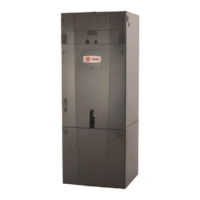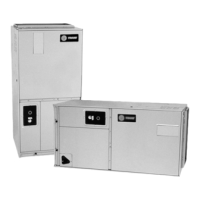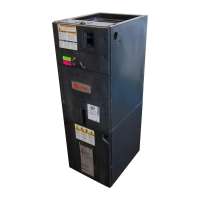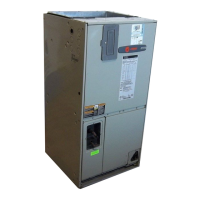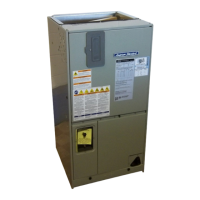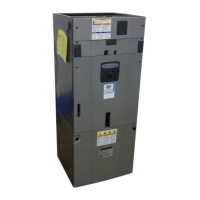BCX-SVX002A-EN
131
Measuring Output Resistance
To measure the resistance of receiver outputs for zone
temperature and setpoints for all models, and heating
setpoint and fan/system for the WDS:
1. Ensure that the GND-SIGNAL (black) wire and the
GND-POWER (yellow) wire are grounded to the
transformer.
2. Disconnect the ZONE (white) and SETPOINT (RED)
wires from the controller. Disconnect the HEAT
SETPOINT (brown) and FAN/SYSTEM (green) wires
from the controller, if applicable.
3. Measure resistance as follows:
a. All models: Measure between the grounded GND-
SIGNAL (black) wire and either the SETPOINT
(red) or ZONE (white) wire. Compare resistance
measurements to those in Table 51, p. 131.
Table 51. Receiver resistance table for all models
Zone or
setpoint
temperature
Nominal zone
temperature
output resistance
Nominal setpoint/
heating setpoint
output resistance
55°F (12.8°C)
17.47 KΩ 792 Ω
60°F (15.6°C)
15.3 KΩ 695 Ω
65°F (18.3°C)
13.49 KΩ 597 Ω
70°F (21.1°C)
11.9 KΩ 500 Ω
75°F (23.9°C)
10.5 KΩ 403 Ω
80°F (26.7°C)
9.3 KΩ 305 Ω
85°F (29.4°C)
8.25 KΩ 208 Ω
b. WDS only: Measure between the grounded GND-
SIGNAL (black) wire and the FAN/SYSTEM (green)
wire. Compare resistance measurements to those
given in Table 52, p. 131.
Note: The output circuits are not electrically powered;
consequently, resistance can be measured
without risk of damage to the volt-ohm meter.
Table 52. Receiver resistance table for model
WDS
Fan command
Nominal output resistance
High
16,130 Ω
Med
13,320 Ω
Low
10,770 Ω
Auto 2320 Ω
Off 4870 Ω
Cleaning the Sensor
NOTICE
Sensor Damage!
Do not spray glass cleaner or any other solution
directly on the sensor as it could damage it.
You can clean the sensor by applying glass cleaner to a
soft, non-abrasive cloth, and gently wiping the face,
including the buttons and LCD display. Use of a
premoistened towelette designed for lens or screen
cleaning is also acceptable.
Avoid inadvertent pressing of the Occupied/Unoccupied
buttons on the keypad on the WDS sensor as this may
result in an unwanted timed override or settings change.
Thermostat
Table 53. Thermostat troubleshooting
Probable Cause/Symptom Explanation
No display Check for voltage at thermostat; display is blank when voltage is not present.
System fan does not come on properly Verify wiring is correct. Check connections are correct (see Configuration Mode Setting 5).
Thermostat turns on and off too frequently Adjust temperature differential (see Configuration Mode Setting 10).
Room temperature is not correct Calibrate thermostat (see Configuration Mode Setting 14). If remote sensor is used, check connections.
Displays Lock symbol when any button is
pressed
Thermostat has the button lockout function activated (see Lockout feature and Configuration Mode Setting
15).
—— Displays instead of room temperature Check for bad connection if remote sensor is used (see Configuration Mode Setting 4).
Heat or cool not coming on (No pipe sensor)
Verify wiring is correct. Gently pull on each wire to verify there is a good connection, verify configuration
settings.
Heat or cool not coming on (Pipe sensor is
connected)
Check pipe sensor temperature by pressing up and down buttons in. If out of range, outputs may not turn on
(see Configuration Mode Settings 6-9).
Diagnostics and Troubleshooting
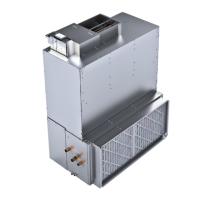
